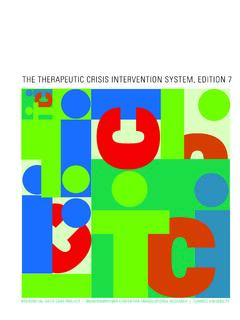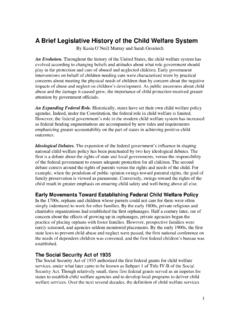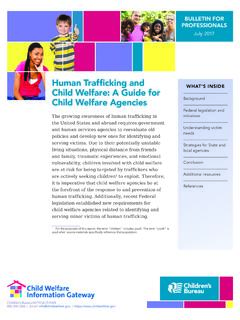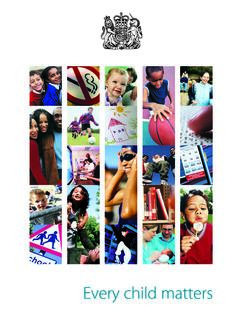Transcription of THE THERAPEUTIC CRISIS INTERVENTION SYSTEM, EDITION 7
1 THE THERAPEUTIC CRISIS INTERVENTION system , EDITION 7. RESIDENTIAL child CARE PROJECT | BRONFENBRENNER CENTER FOR TRANSLATIONAL RESEARCH | CORNELL UNIVERSITY. THERAPEUTIC CRISIS INTERVENTION system , EDITION 7. Information Bulletin Residential child Care Project Bronfenbrenner Center for Translational Research College of Human Ecology Cornell University, Ithaca, NY USA. Residential child Care Project, 2021. Dear Colleague, Enclosed you will find information about our THERAPEUTIC CRISIS INTERVENTION (TCI) system . Our goal is to research, develop, disseminate, and evaluate model techniques to improve the quality of care for children in out-of-home care. In addition, the TCI system is designed to help organiza- tions prevent child retraumatization and injury by reducing the need for physical restraint.
2 In 2020, we launched the 7th EDITION of our TCI system , celebrating 40 years of supporting resi- dential organizations in their efforts to provide safe and quality care for children and young people. When implemented with fidelity, TCI has resulted in an increased ability on the part of staff to manage and prevent crises. Implementation studies have also shown an increased knowledge and skill on the part of all staff to handle CRISIS episodes effectively and a change in attitude regarding the use of physical restraint. If TCI is to be an effective CRISIS management system for your organi- zation, you need to address six general criteria: (a) leadership and program support, (b) child and family inclusion, (c) clinical participation, (d) supervision and post CRISIS response, (e) training and competency standards, and (f) critical incident monitoring and feedback The description of these criteria and the TCI Theory of Change begins on page 17 of this brochure to help you decide whether TCI is right for your organization.
3 The Residential child Care Project supports vigorous and ongoing in-house evaluation of TCI. training and implementation efforts through testing participants' knowledge and skills, offering a trainer certification program, conducting agency TCI quality improvement and fidelity assess- ments, and establishing a TCI agency registration process designed to formally recognize organiza- tions that have implemented the TCI system at the highest RCCP seeks to maintain a leadership role in discovering new knowledge, establishing new approaches to knowledge dis- semination, and developing innovative programs to enable child caring agencies to serve children and families more effectively by building strong linkages among research, outreach activities, and evaluation efforts.
4 If you need any other additional information, please contact us at: Andrea Turnbull at Sincerely, Martha J. Holden Director, Residential child Care Project Contents Preface Preface 2. Research Foundations of TCI. TCI Implementation Study 8. Learning From Tragedy: The Results of a National Study of Fatalities in Out-of-Home Care 14. TCI system Implementation 18. Implementation Criteria 18. The THERAPEUTIC CRISIS INTERVENTION system : A Trauma-Informed Approach 18 The TCI system : The Six Domains 21. Questions for Implementation Assessment 30. Leadership and Program Support 33. Services Offered 33. Model Policy on the Use of Physical INTERVENTION 34. Clinical Participation 37. Services Offered 37. Supervision and Post- CRISIS Support 39.
5 Services Offered 39. Training and Competency Standards 41. Services Offered 41. TCI Trainer Certification Process 42. Agenda: TCI Training of Trainers 43. Documentation, Incident Monitoring, and Feedback 45. Bibliography 47. TCI Faculty, Instructors, and Staff 57. THERAPEUTIC CRISIS INTERVENTION system : Residential child Care Project, Cornell University 1. Preface Preface The Bronfenbrenner Center for that called attention to the large number of envi- ronmental and societal influences on child devel- Translational Research opment. A Cornell alumnus and Cornell profes- sor, Urie Bronfenbrenner helped form the Head The Bronfenbrenner Center for Translational Start Program in the United States in 1965. Research, located within Cornell University's College of Human Ecology, administers the Resi- The BCTR's mission is to improve professional dential child Care Project (RCCP).
6 The BCTR's and public efforts to understand and deal with origins date to 1974, when its parent organization, risk and protective factors in the lives of children, the Family Life Development Center (FLDC), youth, families, and communities that affect fam- was established by New York State legislation ily strength, child wellbeing, and youth develop- under the leadership of John Doris, professor of ment. Translational research, as defined by the human development in the College of Human College and the BCTR, is the systematic applica- Ecology at Cornell. FLDC's mission was to study tion of research findings to the development of and develop programs to prevent child abuse. innovative interventions, practices, and policies that may ultimately improve health and well- On July 1, 2011, FLDC merged with the Bron- being.
7 Conversely, the use of knowledge derived fenbrenner Life Course Center to create the from interventions, practices, and policies helps to Bronfenbrenner Center for Translational Re- inform future research. search (BCTR). The BCTR is named after Urie Bronfenbrenner, an American psychologist who Steve Hamilton, a faculty member of the BCTR, is most known for his ecological systems theory introduced a new model of translational research What's happening? What makes youth tick? Demography Epidemiology Basic Research Observation PRACTICE. How do we use What works? what works? Prevention Diffusion INTERVENTION Dissemination Promotion Scaling Up Evaluation Adaptation Improvement Figure 1. Hamilton Model of Translational Research for Youth Development 2 THERAPEUTIC CRISIS INTERVENTION system : Residential child Care Project, Cornell University Preface for his work in youth de- velopment.
8 Hamilton's model of translational re- Major Programs of The Residential child Care Project search (Figure 1)1 includes four quadrants, each with THERAPEUTIC CRISIS INTERVENTION (TCI) system a different Each Children and Residential Experiences (CARE): Creating quadrant is differentiated Conditions for Change by the types of questions and the types of research The RCCP has delivered programs and consultation services methods most commonly employed. Most impor- throughout the United States, Canada, Puerto Rico, Russia, tantly, practice is deliber- Israel, Australia, South Korea, Ireland, Bermuda, and the United ately placed in the center Kingdom. Used in hundreds of residential child care agencies, of the model with bi-di- TCI has also been adapted for other residential care settings rectional arrows between ( , mental health, juvenile justice) as well as foster, kinship, practice and each quad- rant.
9 Practice can inform and adoptive families (TCIF) and for schools (TCIS). or inspire research and practice can benefit from research in any quadrant. The emphasis on evidence-based practices and A Center for Creating Trauma-Informed translational research in human services, espe- Residential Settings cially Hamilton's model, has the potential to have a significant and positive impact on THERAPEUTIC In 2018, the Residential child Care Project residential services and all the organizations that (RCCP) received a grant from the Depart- serve the best interests of children and their fami- ment of Health and Human Services to establish lies. the Center for Creating Trauma-Informed Resi- dential Settings. The grant is part of the National Since 1980 the Residential child Care Project child Traumatic Stress Network, a federal effort has developed, evaluated, and disseminated two to develop a national network of services for major programs: THERAPEUTIC CRISIS INTERVENTION children and adolescents who have experienced (TCI) and Children and Residential Experiences: trauma.
10 The goal of the grant is to share research, Creating Conditions for Change (CARE). Both strategies, and learning to assist residential set- programs have sought to translate the latest re- tings to use trauma-informed and evidence-based search into practice and to increase the knowl- models and to share the RCCP's THERAPEUTIC edge and expertise of personnel at all levels of CRISIS INTERVENTION (TCI) system and Children child serving organizations. The RCCP's intent and Residential Experiences (CARE): Creating for both programs is to promote more positive Conditions for Change program model with resi- outcomes for children, families, and staff with a dential care centers across the USA. special emphasis on developing healthy relation- ships and safer environments.





